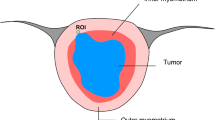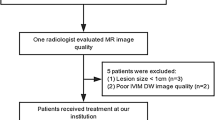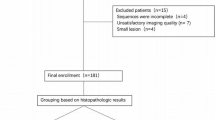Abstract
Objectives
To study the feasibility of dynamic contrast-enhanced magnetic resonance imaging (DCE-MRI) for assessment of tumour microvasculature in endometrial carcinoma patients, and to explore correlations with histological subtype, clinical course and microstructural characteristics based on apparent diffusion coefficient (ADC) values.
Methods
Diffusion-weighted imaging (DWI) and three-dimensional DCE-MRI (1.5 T) with high temporal resolution (2.49 s) were acquired preoperatively in 55 patients. Quantitative modelling allowed the calculation of four independent parameters describing microvasculature: blood flow (Fb), extraction fraction (E), capillary transit time (Tc) and transfer constant from the extravascular extracellular space [EES] to blood (Kep); and four derived parameters: blood volume (Vb), volume of EES (Ve), capillary permeability surface area product (PS) and transfer from blood to EES (Ktrans).
Results
Endometrial carcinoma tissue exhibited reduced Fb, E, Vb, Ve, PS and Ktrans compared with normal myometrium. Non-endometrioid carcinomas (n = 12) had lower Fb, and E than endometrioid carcinomas (n = 43; P < 0.05). Tumour Ve positively correlated with tumour ADC value (r = 0.29, P = 0.03). Reduced survival was observed in patients with low tumour Fb and high tumour Tc (P < 0.05).
Conclusions
We demonstrate the feasibility of DCE-MRI in reflecting histological subtype and clinical course in primary endometrial carcinomas. DCE-MRI may potentially provide future biomarkers for preoperative risk stratification in endometrial carcinomas.
Key Points
• Dynamic contrast-enhanced magnetic resonance imaging (DCE-MRI) offers new information about endometrial carcinoma.
• Pelvic DCE-MRI with subsequent quantitative modelling seems feasible in endometrial carcinoma patients.
• Low tumour perfusion is a feature of a more aggressive tumour subtype.
• DCE-MRI provides potential biomarkers for preoperative risk stratification in endometrial carcinoma patients.




Similar content being viewed by others
Abbreviations
- E:
-
extraction fraction
- EES:
-
extravascular extracellular space
- Fb:
-
blood flow
- Kep:
-
transfer constant from EES to blood
- Ktrans:
-
transfer from blood to EES
- PS:
-
capillary permeability surface area product
- Tc:
-
intravascular/capillary transit time
- Vb:
-
blood volume
- Ve:
-
fractional volume of EES
References
Amant F, Moerman P, Neven P, Timmerman D, Van LE, Vergote I (2005) Endometrial cancer. Lancet 366:491–505
Pecorelli S (2009) Revised FIGO staging for carcinoma of the vulva, cervix, and endometrium. Int J Gynaecol Obstet 105:103–104
Salvesen HB, Haldorsen IS, Trovik J (2012) Markers for individualised therapy in endometrial carcinoma. Lancet Oncol 13:e353–e361
Kinkel K, Kaji Y, Yu KK et al (1999) Radiologic staging in patients with endometrial cancer: a meta-analysis. Radiology 212:711–718
Haldorsen IS, Salvesen HB (2012) Staging of endometrial carcinomas with MRI using traditional and novel MRI techniques. Clin Radiol 67:2–12
Haldorsen IS, Husby JA, Werner HM et al (2012) Standard 1.5-T MRI of endometrial carcinomas: modest agreement between radiologists. Eur Radiol 22:1601–1611
Shen SH, Chiou YY, Wang JH et al (2008) Diffusion-weighted single-shot echo-planar imaging with parallel technique in assessment of endometrial cancer. AJR Am J Roentgenol 190:481–488
Beddy P, Moyle P, Kataoka M et al (2012) Evaluation of depth of myometrial invasion and overall staging in endometrial cancer: comparison of diffusion-weighted and dynamic contrast-enhanced MR imaging. Radiology 262:530–537
Tamai K, Koyama T, Saga T et al (2007) Diffusion-weighted MR imaging of uterine endometrial cancer. J Magn Reson Imaging 26:682–687
Tofts PS, Brix G, Buckley DL et al (1999) Estimating kinetic parameters from dynamic contrast-enhanced T(1)-weighted MRI of a diffusable tracer: standardized quantities and symbols. J Magn Reson Imaging 10:223–232
Harry VN (2010) Novel imaging techniques as response biomarkers in cervical cancer. Gynecol Oncol 116:253–261
Andersen EK, Hole KH, Lund KV et al (2012) Dynamic contrast-enhanced MRI of cervical cancers: temporal percentile screening of contrast enhancement identifies parameters for prediction of chemoradioresistance. Int J Radiat Oncol Biol Phys 82:e485–e492
Zahra MA, Tan LT, Priest AN et al (2009) Semiquantitative and quantitative dynamic contrast-enhanced magnetic resonance imaging measurements predict radiation response in cervix cancer. Int J Radiat Oncol Biol Phys 74:766–773
Coenegrachts K, Bols A, Haspeslagh M, Rigauts H (2012) Prediction and monitoring of treatment effect using T1-weighted dynamic contrast-enhanced magnetic resonance imaging in colorectal liver metastases: potential of whole tumour ROI and selective ROI analysis. Eur J Radiol 81:3870–3876
Kinkel K, Forstner R, Danza FM et al (2009) Staging of endometrial cancer with MRI: guidelines of the European Society of Urogenital Imaging. Eur Radiol 19:1565–1574
Taxt T, Jirik R, Rygh CB et al (2012) Single-channel blind estimation of arterial input function and tissue impulse response in DCE-MRI. IEEE Trans Biomed Eng 59:1012–1021
Gruner R, Taxt T (2006) Iterative blind deconvolution in magnetic resonance brain perfusion imaging. Magn Reson Med 55:805–815
St Lawrence KS, Lee TY (1998) An adiabatic approximation to the tissue homogeneity model for water exchange in the brain: I. Theoretical derivation. J Cereb Blood Flow Metab 18:1365–1377
Silverberg SG, Kurman RJ, Nogales F (2003) Tumors of the uterine corpus. In: Tavassoli FA, Devilee P (eds) Tumours of the breast and female genital organs. World health organization classification of tumours. Pathology & genetics. IACR Press Inc., Lyon, pp 217–258
Carmeliet P, Jain RK (2011) Molecular mechanisms and clinical applications of angiogenesis. Nature 473:298–307
Hanahan D, Weinberg RA (2011) Hallmarks of cancer: the next generation. Cell 144:646–674
Lin G, Ng KK, Chang CJ et al (2009) Myometrial invasion in endometrial cancer: diagnostic accuracy of diffusion-weighted 3.0-T MR imaging—initial experience. Radiology 250:784–792
Rechichi G, Galimberti S, Signorelli M et al (2011) Endometrial cancer: correlation of apparent diffusion coefficient with tumor grade, depth of myometrial invasion, and presence of lymph node metastases. AJR Am J Roentgenol 197:256–262
Perren TJ, Swart AM, Pfisterer J et al (2011) A phase 3 trial of bevacizumab in ovarian cancer. N Engl J Med 365:2484–2496
Acknowledgments
This work was supported by The Western Norway Regional Health Authority, Research Funds at the Department of Radiology, Haukeland University Hospital, MedViz, Norwegian Research Council, The University of Bergen, The Meltzer Foundation, and The Norwegian Cancer Society (The Harald Andersen’s legacy).
Author information
Authors and Affiliations
Corresponding author
Rights and permissions
About this article
Cite this article
Haldorsen, I.S., Grüner, R., Husby, J.A. et al. Dynamic contrast-enhanced MRI in endometrial carcinoma identifies patients at increased risk of recurrence. Eur Radiol 23, 2916–2925 (2013). https://doi.org/10.1007/s00330-013-2901-3
Received:
Revised:
Accepted:
Published:
Issue Date:
DOI: https://doi.org/10.1007/s00330-013-2901-3




